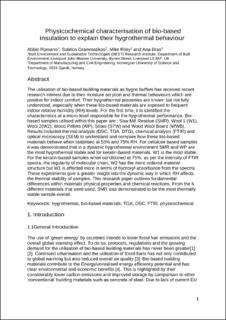| dc.contributor.author | Romano, Abbie | |
| dc.contributor.author | Grammatikos, Sotirios | |
| dc.contributor.author | Riley, Mike | |
| dc.contributor.author | Bras, Ana | |
| dc.date.accessioned | 2021-06-09T08:16:06Z | |
| dc.date.available | 2021-06-09T08:16:06Z | |
| dc.date.created | 2021-01-20T16:51:32Z | |
| dc.date.issued | 2020 | |
| dc.identifier.citation | Construction and Building Materials. 2020, 258, . | en_US |
| dc.identifier.issn | 0950-0618 | |
| dc.identifier.uri | https://hdl.handle.net/11250/2758635 | |
| dc.description.abstract | The utilisation of bio-based building materials as hygric buffers has received recent research interest due to their moisture sorption and thermal behaviours which are positive for indoor comfort. Their hygrothermal properties are known but not fully understood, especially when these bio-based materials are exposed to frequent indoor relative humidity (RH) levels. For the first time, it is identified the characteristics at a micro-level responsible for the hygrothermal performance. Bio-based samples utilised within this paper are: Saw Mill Residue (SMR), Wool 1 (W1), Wool 2(W2), Wood Pellets (WP), Straw (STW) and Wood Wool Board (WWB). Results included thermal analysis (DSC, TGA, DTG), chemical analysis (FTIR) and optical microscopy (SEM) to understand and compare how these bio-based materials behave when stabilised at 53% and 75% RH. For cellulose based samples it was demonstrated that in a dynamic hygrothermal environment SMR and WP are the most hygrothermal stable and for keratin-based materials, W1 is the most stable. For the keratin-based samples when conditioned at 75%, as per the intensity of FTIR spectra, the regularity of molecular chain, W2 has the more ordered material structure but W1 is affected more in terms of hydroxyl absorbance from the spectra. These experiments give a greater insight into the dynamic way in which RH affects the thermal stability of samples. This research paper outlines fundamental differences within materials physical properties and chemical reactions. From the 6 different materials that were used, SMR was demonstrated to be the most thermally stable sample overall. | en_US |
| dc.language.iso | eng | en_US |
| dc.publisher | Elsevier Ltd. | en_US |
| dc.rights | Attribution-NonCommercial-NoDerivatives 4.0 Internasjonal | * |
| dc.rights.uri | http://creativecommons.org/licenses/by-nc-nd/4.0/deed.no | * |
| dc.title | Physicochemical characterisation of bio-based insulation to explain their hygrothermal behaviour | en_US |
| dc.type | Peer reviewed | en_US |
| dc.type | Journal article | en_US |
| dc.description.version | acceptedVersion | en_US |
| dc.source.pagenumber | 15 | en_US |
| dc.source.volume | 258 | en_US |
| dc.source.journal | Construction and Building Materials | en_US |
| dc.identifier.doi | 10.1016/j.conbuildmat.2020.120163 | |
| dc.identifier.cristin | 1875852 | |
| dc.description.localcode | © 2020. This is the authors’ accepted and refereed manuscript to the article. Locked until 30 August 2022 due to copyright restrictions. This manuscript version is made available under the CC-BY-NC-ND 4.0 license http://creativecommons.org/licenses/by-nc-nd/4.0/ | en_US |
| dc.source.articlenumber | 120163 | en_US |
| cristin.ispublished | true | |
| cristin.fulltext | postprint | |
| cristin.qualitycode | 2 | |

